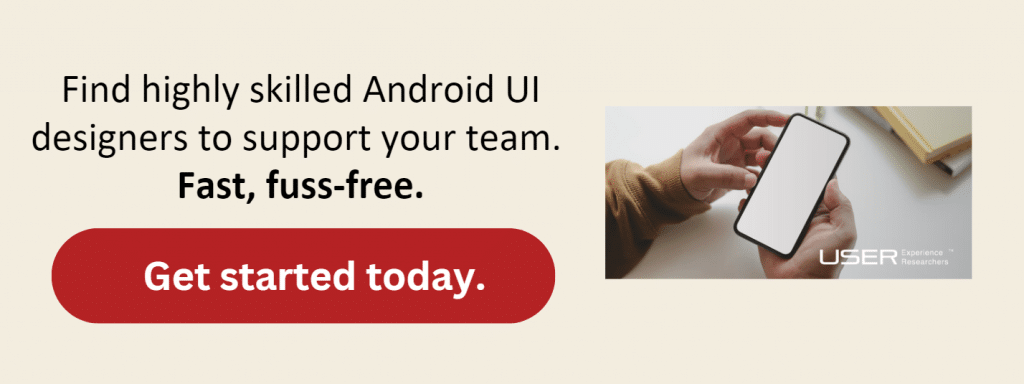Creating user interfaces often requires a collaborative dialogue between designers and the end-users they serve. To enhance the user experience continually, it’s essential for UI designers to grasp the nuances of user requirements.
The complexity lies in the myriad of elements that influence the final design outcome. These elements include the ever-shifting landscape of user preferences, current design trends, and ongoing technological innovations.
Despite the extensive array of factors to consider, the discipline of UI design demands relentless focus, especially within the realm of Android app development. This is because a well-crafted user interface is a foundation for the development of a positive user experience and for ensuring sturdy app performance.

In 2022 alone, Android applications saw a staggering 100 billion downloads. To ensure your application garners the attention and market share it deserves, the expertise of professional UI designers is crucial.
These designers are tasked with addressing and resolving common issues found in earlier design iterations. Their contribution is vital, directly impacting user contentment. As such, they must embody certain attributes to excel in their roles and distinguish themselves amidst a sea of talent. This post will explore some of these key attributes.
1. Developing designs with creativity and perseverance
A designer’s prerequisite skill is creativity. Without it, creating a functional design, let alone visualizing it, will be difficult.
For a UI designer, it’s not enough to be merely creative, being patient with the process is also imperative. Several factors must be taken into account when developing designs, and having patience will keep them from becoming overwhelmed.
Android is the most widely used mobile operating system in the world. Its users have diverse characteristics that influence their perception of a design. Android devices are also used for different purposes by different people, may it be for professional or personal use.
As such, UI designers should create designs that could satisfy professional and personal needs. Fortunately, Android is flexible when it comes to design, which means greater freedom to explore creative ideas.
Finally, as a designer, you’ll always be working with various individuals, such as a UX designer. You must be patient with others and be open to criticism to ensure the quality of the design and a positive user experience.
Read: A Guide to the Differences and Responsibilities of UX and UI Design
2. Staying intuitive and flexible to changes
A designer should understand the behavior of their users and their environment.
Since its initial release in 2008, Android’s ecosystem has undergone significant changes. From their transition from dark colors to bright ones, card-based concepts, and the introduction of Google Assistant, Android’s extensive upgrades are for the benefit of its users.
The introduction of Material Design, which is an Android-oriented design language created by Google, paved the way for much simpler and more functional designs. Android UI designers must be adaptive to these changes.
In 2018, Google launched the latest version of Material Design which is called Material You, which uses a humanistic approach towards design. Users want more control and expression over their devices. That’s why Material You created designs that can be personalized and are adaptable for its users.
A UI designer must also anticipate possible constraints in these developments and produce intuitive designs. They should be able to understand the needs of their users. Being adaptive to these developments will help in creating designs that provide a smooth overall user experience.
3. Exploring the open nature of Android UI design with an open mind
Uniqueness is something that consumers look forward to when it comes to designs.
Most of the time, an application designer follows a set of guidelines that they incorporate in their design. However, aiming for non-conventional designs challenges the norms and opens a lot of opportunities in UI design. It’s a risky move, but out-of-the-box designs set an application apart from its competitors.
Read: Android UI Design for the Modern Market
It’s wise to follow traditions in design, especially if you’re a beginner, but don’t be constrained by it. As a creative, continually exploring and adapting to changes is necessary to boost competitiveness.
4. Emphatizing for Good UI Design
Looking for Android UI Designers to Work With Your Team?
Forbes predicts that UI design, as a tech skill, will continue to grow over the next decade as companies undergo digital transformation.
If you’re looking for competent Android UI designers, User Experience Researchers, a Singapore-based leading UX UI agency offering strategic and innovative designs, can refer highly skilled candidates to your team.







